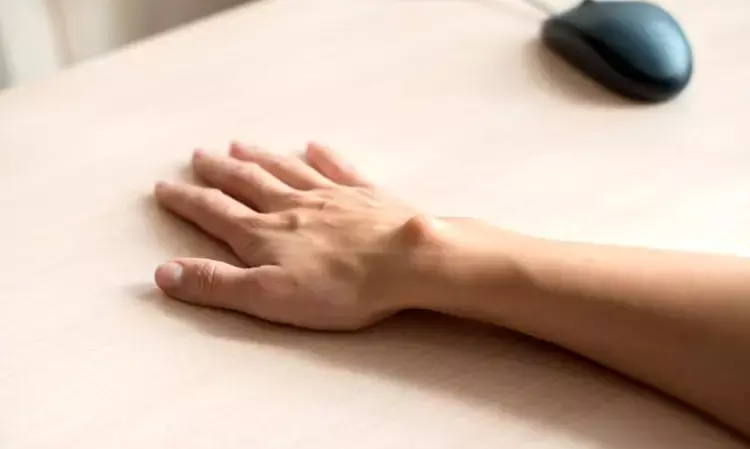- Home
- Medical news & Guidelines
- Anesthesiology
- Cardiology and CTVS
- Critical Care
- Dentistry
- Dermatology
- Diabetes and Endocrinology
- ENT
- Gastroenterology
- Medicine
- Nephrology
- Neurology
- Obstretics-Gynaecology
- Oncology
- Ophthalmology
- Orthopaedics
- Pediatrics-Neonatology
- Psychiatry
- Pulmonology
- Radiology
- Surgery
- Urology
- Laboratory Medicine
- Diet
- Nursing
- Paramedical
- Physiotherapy
- Health news
- Fact Check
- Bone Health Fact Check
- Brain Health Fact Check
- Cancer Related Fact Check
- Child Care Fact Check
- Dental and oral health fact check
- Diabetes and metabolic health fact check
- Diet and Nutrition Fact Check
- Eye and ENT Care Fact Check
- Fitness fact check
- Gut health fact check
- Heart health fact check
- Kidney health fact check
- Medical education fact check
- Men's health fact check
- Respiratory fact check
- Skin and hair care fact check
- Vaccine and Immunization fact check
- Women's health fact check
- AYUSH
- State News
- Andaman and Nicobar Islands
- Andhra Pradesh
- Arunachal Pradesh
- Assam
- Bihar
- Chandigarh
- Chattisgarh
- Dadra and Nagar Haveli
- Daman and Diu
- Delhi
- Goa
- Gujarat
- Haryana
- Himachal Pradesh
- Jammu & Kashmir
- Jharkhand
- Karnataka
- Kerala
- Ladakh
- Lakshadweep
- Madhya Pradesh
- Maharashtra
- Manipur
- Meghalaya
- Mizoram
- Nagaland
- Odisha
- Puducherry
- Punjab
- Rajasthan
- Sikkim
- Tamil Nadu
- Telangana
- Tripura
- Uttar Pradesh
- Uttrakhand
- West Bengal
- Medical Education
- Industry
Aspiration of Pediatric Wrist Ganglion Cysts has higher rates of recurrence: JHS study

Dallas, TEXAS: Ganglion cysts arise in all age groups and populations, but are most commonly seen in the young adult female population; with an estimated 70% of cysts occurring in people aged 20-40. In children, the spontaneous resolution rate with observation alone ranges from 48% to 83%.
The treatment of ganglion cysts of the wrist remains understudied in the pediatric population, with the literature showing variable recurrence rates following different interventions.
Carolyn Shanks et al did a study to determine whether surgical and nonsurgical management of pediatric ganglion cysts was associated with improved resolution rates when compared to observation alone.
• The authors identified 654 cases of pediatric ganglion cysts treated across 5 institutions.
• The mean age at presentation was 11.6+/- 5.2 years.
• Of the patients, 315 had >2 years (mean, 50.0 months) of follow-up, either via chart review or telephone callbacks.
• There were 4 different treatment groups: (1) observation, (2) cyst aspiration, (3) removable orthosis, and (4) surgical excision.
• For patients followed >2 years, the cyst resolved in 44% (72/163) of those observed.
• Only 18% (9/49) of those treated with aspiration resolved.
• 55% (12/22) of those treated with an orthosis resolved.
• Surgical excision was associated with resolution of the cyst in 73% (59/81) of patients.
• Observation had higher rates of cyst resolution compared to aspiration.
• Orthosis fabrication and observation had similar rates of cyst resolution.
• Surgery had the highest rates of resolution when compared to observation and aspiration.
• Patients older than 10 years were less likely to have the cyst resolve with observation (35%; 28/80) than those younger than 10 years (53%; 44/83) at >2 years of follow-up.
This study did not find evidence that nonsurgical treatments were associated with improved rates of cyst resolution compared to observation alone in a large pediatric sample.
Surgical excision had the overall highest rate of resolution. Despite the costs and increased clinic time of orthosis fabrication and aspiration, these treatments were not associated with improved rates of cyst resolution in pediatric ganglion cysts compared to observation, with aspiration having higher rates of recurrence compared to observation.
The authors no longer offer aspiration or orthosis fabrication as methods of definitive treatment of pediatric ganglion cysts, although aspiration may be offered as a temporizing method for children who are experiencing limitations in sports and activities and wish to defer possible surgery to a more convenient time if the cyst recurs after aspiration.
Key Words: Ganglion cyst, aspiration, observation, pediatric, the Journal of Hand Surgery.
Type of study/level of evidence: Therapeutic IV
The Efficacy of Nonsurgical and Surgical Interventions in the Treatment of Pediatric Wrist Ganglion Cysts
Carolyn Shanks, Tyler Schaeffer, David P. Falk et al
J Hand Surg Am. 2022;47(4):341- 347
https://doi.org/10.1016/j.jhsa.2021.12.005
MBBS, Dip. Ortho, DNB ortho, MNAMS
Dr Supreeth D R (MBBS, Dip. Ortho, DNB ortho, MNAMS) is a practicing orthopedician with interest in medical research and publishing articles. He completed MBBS from mysore medical college, dip ortho from Trivandrum medical college and sec. DNB from Manipal Hospital, Bengaluru. He has expirence of 7years in the field of orthopedics. He has presented scientific papers & posters in various state, national and international conferences. His interest in writing articles lead the way to join medical dialogues. He can be contacted at editorial@medicaldialogues.in.
Dr Kamal Kant Kohli-MBBS, DTCD- a chest specialist with more than 30 years of practice and a flair for writing clinical articles, Dr Kamal Kant Kohli joined Medical Dialogues as a Chief Editor of Medical News. Besides writing articles, as an editor, he proofreads and verifies all the medical content published on Medical Dialogues including those coming from journals, studies,medical conferences,guidelines etc. Email: drkohli@medicaldialogues.in. Contact no. 011-43720751


